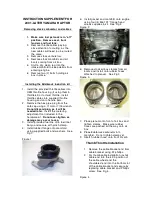
Make sure that the load is secure before every
journey and at regular intervals during a long jour-
ney. Adjust the load securing as necessary. Infor-
mation on how to secure loads correctly can be
obtained from the manufacturers of the load
securing aids or tie downs for load securing, for
example.
When securing loads, observe the following:
R
Fill spaces between the load and the cargo
compartment walls or wheel wells. For this pur-
pose, use rigid load securing aids, such as
chocks, wooden xings or padding.
R
Attach secured and stabilized loads in all direc-
tions.
Use the cargo tie-down points or tie-down eyes
and the loading rails in the cargo compart-
ment.
Only use tie downs, such as lashing rods, lock
rods or lashing nets and lashing straps, which
have been tested in accordance with current
standards (e.g. DIN EN). Always use the cargo
tie-down points closest to the load and pad
sharp edges.
Loads, and heavy loads in particular, should
preferably be secured using the tie-down eyes.
%
You can obtain tie downs tested in accordance
with current standards (e.g. DIN EN) from any
specialist company or from a quali ed special-
ist workshop.
NNoottes on t
es on the par
he partition
tition
Without a partition, vehicles that are approved as
commercial vehicles (vehicle category N1, N2) do
not ful ll standard ISO 27956, which describes the
equipment for properly securing a load in delivery
vehicles. If the vehicle is used to transport goods,
retro tting the partition is strongly recommended,
as properly securing the load in vehicles without a
partition will always be a complex operation.
%
Nothing may be stowed in the area between
the rear side of the seats and the partition.
Ov
Over
ervie
view of car
w of cargo tie-do
go tie-down points
wn points
Cargo tie-down points (example: Cargo Van
without loading rails)
1
Tie-down eyes
Secure loose loads with an approved lashing net or
a tarp.
Always fasten the lashing net or tarp to all available
cargo tie-down points. Make sure that the fasten-
ing hooks are secured against accidental opening.
If your vehicle is equipped with loading rails in the
cargo compartment oor, you can place lashing
rods directly in front of and behind the load. The
lashing rods directly absorb the potential shi ing
forces.
Securing loads on the cargo compartment oor by
lashing them down is only recommended for light-
weight loads. Lay anti-slip mats under the load to
assist in securing it.
Inst
Installing and r
alling and remo
emoving tie-do
ving tie-down ey
wn eyes
es
#
TTo inst
o install:
all: slide the tie-down eye through a
recess in the loading rail close to the load until
the locking mechanism engages in the recess.
%
When you pull the locking mechanism up and
out of the recess, the tie-down eye is able to
move within the loading rail. Make sure that
the locking mechanism is always engaged in a
recess.
#
Check the tie-down eye for rm seating.
#
TTo r
o remov
emove:
e: pull the locking mechanism up and
pull the tie-down eye towards the locking
mechanism and out of the loading rail through
a recess.
204
204 Transporting
















































